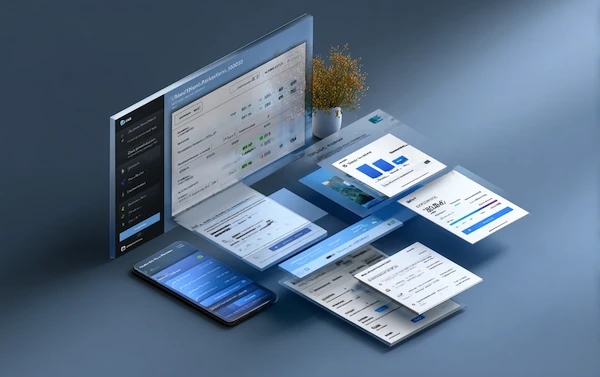Coming Up
What is Automated Revenue Forecasting?
Automated revenue forecasting uses advanced software tools and AI-powered algorithms to predict a company’s future revenue based on historical data, current sales performance, and market trends. These tools automate the traditionally manual processes of collecting, analyzing, and reporting financial data, providing businesses with more accurate and timely forecasts. With automation, companies can avoid errors associated with manual data entry and human oversight, while also benefiting from real-time data integration that enables ongoing updates and refinements to forecasts.
Why is Automated Revenue Forecasting Important?
Revenue forecasting is essential for businesses to plan for growth, manage resources, and make strategic decisions. Automating the process enhances its accuracy and efficiency, which is critical in today’s fast-paced business environment. Traditional methods are time-consuming and prone to error, often resulting in outdated or incomplete insights. Automation allows businesses to:
- Reduce manual labor and focus on high-value activities.
- Receive real-time updates as new data becomes available.
- Improve accuracy by eliminating human error and incorporating predictive analytics.
- Increase flexibility by easily adjusting forecasts based on new variables or market conditions.
For instance, companies leveraging automated revenue forecasting can quickly identify potential risks in their sales pipeline and adjust strategies accordingly, leading to better financial management and more informed decision-making.
What are the Benefits of Automated Revenue Forecasting?
The shift to automated revenue forecasting offers several key advantages:
- Increased Accuracy: Automated tools analyze vast amounts of data with precision, minimizing the risk of human error. By incorporating historical data, AI-driven platforms can provide highly accurate revenue predictions based on patterns and trends.
- Real-Time Forecasting: Automated solutions offer real-time updates by continuously integrating new data sources. This means forecasts are not static but evolve as new financial, operational, and market data becomes available.
- Improved Decision-Making: Access to accurate and up-to-date revenue forecasts allows companies to make more informed decisions regarding resource allocation, market expansion, and product development. Real-time analytics highlight key insights, allowing leaders to act promptly on emerging trends.
- Scalability: Automation tools can handle large and complex datasets, making them ideal for enterprises looking to scale their operations. As businesses grow, automated systems can manage the increased data volume and provide accurate forecasts for multiple business segments.
- Enhanced Collaboration: Many automated platforms integrate with financial planning tools, allowing cross-functional teams (such as finance, marketing, and sales) to collaborate more efficiently. Shared dashboards and real-time data analysis foster a unified approach to forecasting.
What are the Challenges of Automated Revenue Forecasting?
While automated revenue forecasting offers significant benefits, there are challenges businesses may encounter during implementation:
- Initial Setup Complexity: Implementing an automated solution requires thorough planning, including data integration from various systems. The setup process can be complex, particularly for companies with siloed data or outdated systems.
- Learning Curve: Employees may need time to adjust to new tools and processes. Training and a clear understanding of the technology are essential for ensuring the team can fully leverage the benefits of automation.
- Dependence on Data Quality: Automated forecasts are only as accurate as the data they are based on. Companies need to ensure their data is clean, consistent, and up-to-date to avoid inaccurate predictions.
- Cost Considerations: While automation reduces manual labor in the long run, the initial investment in software and technology can be significant. Companies must weigh the upfront costs against long-term savings and efficiency gains.
How Does Automated Revenue Forecasting Work?
Automated revenue forecasting tools typically function by analyzing a mix of internal and external data, using machine learning algorithms to detect trends and patterns. The process often includes:
- Data Collection: Automated systems gather data from various sources, such as CRM platforms, accounting software, and market research databases.
- Data Integration: The collected data is integrated into the system, allowing the forecasting tool to process the information holistically. This includes sales performance, customer behavior, and market conditions.
- Modeling and Forecasting: Using predefined models, such as top-down or bottom-up forecasting, the tool analyzes the data to project future revenue. Some systems allow users to customize the model based on specific business needs.
- Scenario Analysis: Many tools include scenario planning features, allowing businesses to create "what-if" scenarios and explore how changes in market conditions, pricing, or customer behavior could impact revenue.
What are the Types of Revenue Forecasting Models?
There are several common models used in automated revenue forecasting:
- Top-Down Forecasting: Estimates future revenue based on overall market size and the company’s projected market share. This approach is often used by large enterprises.
- Bottom-Up Forecasting: Focuses on detailed analysis of individual products or services to build up to a total revenue projection. This model is useful for startups or businesses with diverse offerings.
- Pipeline Forecasting: Based on the sales pipeline, it estimates future revenue by analyzing opportunities at different stages of the sales process.
- Historical Performance Forecasting: Uses past sales data and trends to project future revenue. It’s suitable for businesses with steady revenue patterns.
Best Practices for Automated Revenue Forecasting
To maximize the benefits of automated revenue forecasting, businesses should follow these best practices:
- Ensure Data Accuracy: Clean, consistent data is critical to accurate forecasts. Regularly update and validate data to ensure it reflects current business realities.
- Leverage Scenario Analysis: Use forecasting tools that support scenario modeling to understand how different strategies may impact revenue.
- Integrate Across Teams: Ensure that all departments (sales, finance, marketing) contribute relevant data and insights to the forecasting process, fostering collaboration.
- Choose the Right Tool: Select a solution that fits your company’s size, needs, and industry. Consider scalability, ease of use, and integration capabilities when making your decision.
How Solvexia Can Help with Automated Revenue Forecasting
Solvexia offers an automation platform designed to simplify complex financial processes like revenue forecasting. By automating data consolidation, reporting, and scenario analysis, Solvexia’s platform helps businesses streamline their forecasting activities, improving accuracy and efficiency. Solvexia integrates easily with existing financial systems and allows for real-time updates, making it an ideal choice for organizations looking to enhance their revenue forecasting capabilities.
.svg)































